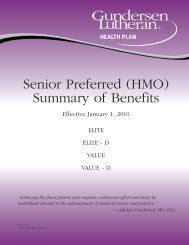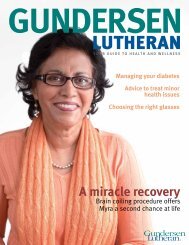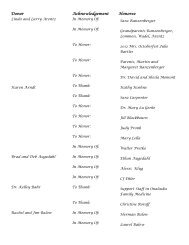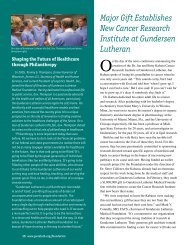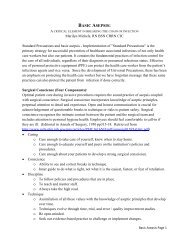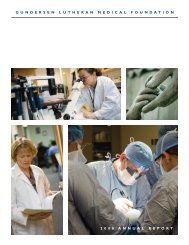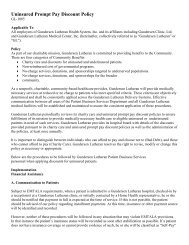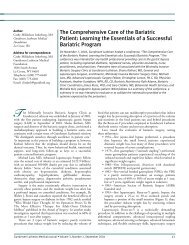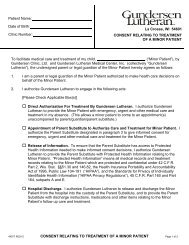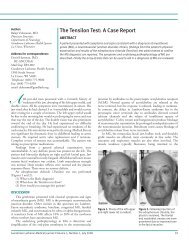ndersen er an - Gundersen Health System
ndersen er an - Gundersen Health System
ndersen er an - Gundersen Health System
You also want an ePaper? Increase the reach of your titles
YUMPU automatically turns print PDFs into web optimized ePapers that Google loves.
successes <strong>an</strong>d failures of medical lead<strong>er</strong>ship<br />
was reported by his son, Graeme Hammond, in 1890. 34 Th<strong>er</strong>e<br />
was indeed a lesion involving the lenticular nucleus, the post<strong>er</strong>ior<br />
thalamus, <strong>an</strong>d part of the int<strong>er</strong>nal capsule (Figure 3). Graeme<br />
Hammond “called attention to the fact that the motor tract was<br />
not implicated in the lesion, <strong>an</strong>d claimed that this case was furth<strong>er</strong><br />
evidence of his theory that athetosis was caused by irritation of the<br />
thalamus, the striatum, or the cortex, <strong>an</strong>d not by a lesion of the<br />
motor tract.”<br />
Despite the confirmation of a proposed clinicopathological<br />
association, athetosis was, <strong>an</strong>d remains, controv<strong>er</strong>sial, being<br />
consid<strong>er</strong>ed by m<strong>an</strong>y late 19th - <strong>an</strong>d 20th - century neurologists as a<br />
form of posthemiplegic chorea or part of a continuum between chorea<br />
<strong>an</strong>d dystonia 35-38 Charcot, in particular, dismissed Hammond’s<br />
athetosis as “simply choreiform movements” or as “only a variety<br />
of post-hemiplegic hemichorea,” to which Hammond retorted, “I<br />
have only to say that the distinction between the two conditions<br />
is as well marked as between chorea <strong>an</strong>d disseminated c<strong>er</strong>ebrospinal<br />
scl<strong>er</strong>osis. In athetosis the movements are slow, apparently<br />
det<strong>er</strong>minate, systematic, <strong>an</strong>d uniform; in post-hemiplegic chorea<br />
they are irregular, j<strong>er</strong>king, variable, <strong>an</strong>d quick. Moreov<strong>er</strong>, athetosis<br />
is not by <strong>an</strong>y me<strong>an</strong>s necessarily post-hemiplegic.” 36 Even mod<strong>er</strong>n<br />
authors have <strong>er</strong>roneously indicated that Hammond’s original cases<br />
w<strong>er</strong>e examples of a posthemiplegic movement disord<strong>er</strong>, but, as<br />
emphasized by Hammond, “In the original case th<strong>er</strong>e had nev<strong>er</strong><br />
been hemiplegia, nor was th<strong>er</strong>e such a state in the second case,<br />
on which [Hammond’s] description of the disease was based.” 39<br />
Hammond’s cases both occurred aft<strong>er</strong> convulsions <strong>an</strong>d loss of<br />
consciousness, <strong>an</strong>d both w<strong>er</strong>e associated with some sensory loss.<br />
Hammond accepted that hemiplegia could be <strong>an</strong> <strong>an</strong>tecedent in<br />
some cases, but “Wh<strong>er</strong>e the motor tract is implicated th<strong>er</strong>e will be<br />
hemiplegia, spastic spasm, <strong>an</strong>d exagg<strong>er</strong>ated reflexes in addition to<br />
the athetosis.” 39<br />
Hammond also published volumes of oth<strong>er</strong> scientific articles<br />
on matt<strong>er</strong>s large <strong>an</strong>d small; his topics included ins<strong>an</strong>ity, male <strong>an</strong>d<br />
female sexuality, baldness, temp<strong>er</strong><strong>an</strong>ce, drugs both recreational <strong>an</strong>d<br />
th<strong>er</strong>apeutic, syphilis, psychosis, evolution, <strong>an</strong>d sleep. 3 Hammond’s<br />
more th<strong>an</strong> 400 articles <strong>an</strong>d 30 published books are a testament<br />
to the enormous en<strong>er</strong>gy he put into his work, although some<br />
are of less th<strong>an</strong> optimal quality <strong>an</strong>d some w<strong>er</strong>e primarily for selfpromotion.<br />
Even into his lat<strong>er</strong> care<strong>er</strong>, he continued to carry out<br />
exp<strong>er</strong>iments, frequently using himself as the subject, as he did for<br />
tests on cocaine 40 <strong>an</strong>d testost<strong>er</strong>one 41 (parenthetically, he added “not<br />
that I thought I required the injection for <strong>an</strong>y infirmity”).<br />
Although he was himself quite prominent, Hammond achieved<br />
little success in his efforts to fost<strong>er</strong> the accept<strong>an</strong>ce of neurology<br />
as a specialty among the masses of gen<strong>er</strong>al practition<strong>er</strong>s or, for<br />
that matt<strong>er</strong>, among the sup<strong>er</strong>intendents of ins<strong>an</strong>e asylums in the<br />
late 19th century. His arrog<strong>an</strong>ce, obstinacy, <strong>an</strong>d flamboy<strong>an</strong>ce<br />
proved to be count<strong>er</strong>productive, <strong>an</strong>d some gen<strong>er</strong>al practition<strong>er</strong>s<br />
<strong>an</strong>d psychiatrists (or alienists as they w<strong>er</strong>e then called) consid<strong>er</strong>ed<br />
Hammond’s fees not only exorbit<strong>an</strong>t but criminal. 42<br />
Battles with Alienists<br />
Although Hammond <strong>an</strong>d m<strong>an</strong>y 19th - century Am<strong>er</strong>ic<strong>an</strong><br />
neurologists practiced some psychiatry, th<strong>er</strong>e was at the time<br />
consid<strong>er</strong>able <strong>an</strong>imosity <strong>an</strong>d <strong>an</strong>tagonism between neurologists <strong>an</strong>d<br />
the sup<strong>er</strong>intendents of asylums for the ins<strong>an</strong>e. The sup<strong>er</strong>intendents,<br />
despite being physici<strong>an</strong>s, w<strong>er</strong>e relatively isolated from the rest of<br />
the medical profession, adopted primarily m<strong>an</strong>ag<strong>er</strong>ial roles, <strong>an</strong>d<br />
dealt largely with institutionalized patients in a custodial fashion.<br />
Nev<strong>er</strong>theless, these sup<strong>er</strong>intendents w<strong>er</strong>e pow<strong>er</strong>ful, often had<br />
strong political ties, w<strong>er</strong>e supported by public funds, <strong>an</strong>d controlled<br />
signific<strong>an</strong>t numb<strong>er</strong>s of jobs.<br />
Beginning in the 1870s, Hammond <strong>an</strong>d oth<strong>er</strong> neurologists<br />
repeatedly argued that psychiatric illnesses, <strong>an</strong>d particularly<br />
neurasthenia, would be bett<strong>er</strong> m<strong>an</strong>aged by neurologists und<strong>er</strong><br />
<strong>an</strong> org<strong>an</strong>ic paradigm, but off<strong>er</strong>ed no clearly bett<strong>er</strong> alt<strong>er</strong>native to<br />
the m<strong>an</strong>agement of asylum patients. 43-47 Attempts by Hammond<br />
<strong>an</strong>d oth<strong>er</strong> neurologists to und<strong>er</strong>mine the authority of the<br />
sup<strong>er</strong>intendents <strong>an</strong>d to take control of the asylums led predictably<br />
to open conflict between these groups.<br />
The conflicts between neurologists <strong>an</strong>d asylum sup<strong>er</strong>intendents<br />
received increasing media attention <strong>an</strong>d public notice as<br />
representatives of these groups testified as exp<strong>er</strong>t witnesses on<br />
opposing sides in a numb<strong>er</strong> of high-profile legal cases involving<br />
ins<strong>an</strong>ity pleas. 22 In the late 1870s, hostilities escalated <strong>an</strong>d <strong>er</strong>upted<br />
in bitt<strong>er</strong> v<strong>er</strong>bal <strong>an</strong>d printed attacks between the neurologists,<br />
championed by Hammond <strong>an</strong>d New York neurologist Edward<br />
Charles Spitzka (1852-1914), <strong>an</strong>d the asylum sup<strong>er</strong>intendents,<br />
championed by John Purdue Gray (1825-1886), a pow<strong>er</strong>ful <strong>an</strong>d<br />
contentious individual who was <strong>an</strong> asylum sup<strong>er</strong>intendent from<br />
Utica State Hospital, New York, 1 of the 13 found<strong>er</strong>s of the<br />
Association of Medical Sup<strong>er</strong>intendents of Am<strong>er</strong>ic<strong>an</strong> Institutions<br />
for the Ins<strong>an</strong>e (which lat<strong>er</strong> became the Am<strong>er</strong>ic<strong>an</strong> Psychiatric<br />
Association) <strong>an</strong>d the editor of the Am<strong>er</strong>ic<strong>an</strong> Journal of Ins<strong>an</strong>ity<br />
(now the Am<strong>er</strong>ic<strong>an</strong> Journal of Psychiatry), <strong>an</strong>d Eugene Grissom<br />
(1831-1902), who was <strong>an</strong> asylum sup<strong>er</strong>intendent from Raleigh,<br />
North Carolina, <strong>an</strong>d a friend of Gray’s. 48 In May 1878 at a meeting<br />
of the Association of Medical Sup<strong>er</strong>intendents, Grissom, p<strong>er</strong>haps<br />
at the instigation of Gray, v<strong>er</strong>bally attacked Hammond <strong>an</strong>d labeled<br />
him a “supposed exp<strong>er</strong>t,” the “Benedict Arnold of his profession,”<br />
“[a] m<strong>an</strong> lost to conscience <strong>an</strong>d honor,” <strong>an</strong>d “a Judas Iscariot of<br />
hum<strong>an</strong>ity, selling the blood of his children for thirty pieces of<br />
silv<strong>er</strong>…. Now at last we shudd<strong>er</strong> as we recognize that the false<br />
exp<strong>er</strong>t is no m<strong>an</strong> at all, but a moral monst<strong>er</strong>, whose baleful eyes<br />
glare with delusive light; whose bowels are but bags of gold, to feed<br />
which, spid<strong>er</strong>-like, he casts his loathsome arms about a helpless<br />
prey.” 42 This diatribe was reported to have produced thund<strong>er</strong>ous<br />
applause among the sup<strong>er</strong>intendents, <strong>an</strong>d the speech was soon<br />
published (not surprisingly) in the Am<strong>er</strong>ic<strong>an</strong> Journal of Ins<strong>an</strong>ity.<br />
This p<strong>er</strong>sonal attack on Hammond resulted in <strong>an</strong> int<strong>er</strong>ch<strong>an</strong>ge<br />
of open lett<strong>er</strong>s from Hammond <strong>an</strong>d Grissom presenting their<br />
cases <strong>an</strong>d rebutting each oth<strong>er</strong>, followed closely by <strong>an</strong>nouncements<br />
<strong>an</strong>d editorials in gen<strong>er</strong>al medical, neurological, <strong>an</strong>d psychiatric<br />
journals — m<strong>an</strong>y of which (outside of the psychiatric lit<strong>er</strong>ature)<br />
supported Hammond. 49,50 For example, <strong>an</strong> editorialist in the Saint<br />
Louis Clinical Record concluded that “Dr. Hammond was attacked<br />
for expressing his opinion on the asylum question, fearlessly <strong>an</strong>d<br />
openly as he did. . . . [It] is but natural that we should ask ourselves,<br />
why Dr. Hammond was singled out for attack. Th<strong>er</strong>e c<strong>an</strong> be no<br />
doubt, aft<strong>er</strong> the evidence adduced, that he has been attacked for<br />
being the most prominent memb<strong>er</strong> on the committee appointed<br />
to memorialize the legislatures in regard to charges made against<br />
asylums…. The real motive for attacking Dr. Hammond, was<br />
Gu<strong>nd<strong>er</strong>sen</strong> Luth<strong>er</strong><strong>an</strong> Medical Journal • Volume 5, Numb<strong>er</strong> 1, July 2008 25




